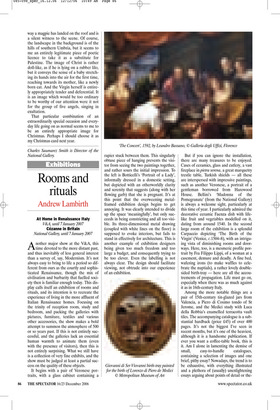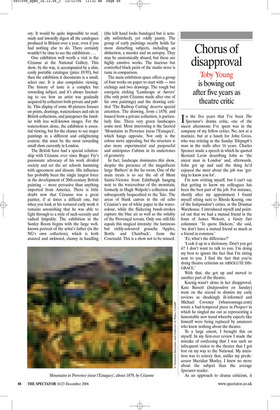Rooms and rituals
Andrew Lambirth
At Home in Renaissance Italy V&A, until 7 January 2007 Cézanne in Britain National Gallery, until 7 January 2007 Another major show at the V&A, this time devoted to the more distant past, and thus inevitably of less general interest than a survey of, say, Modernism. It’s not always easy to bring to life a period so different from ours as the courtly and sophisticated Renaissance, though the mix of civilisation and barbarity that fuelled society then is familiar enough today. This display calls itself an exhibition of rooms and rituals, and its intention is to recreate the experience of living in the more affluent of Italian Renaissance homes. Focusing on the trinity of reception room, study and bedroom, and packing the galleries with pictures, furniture, textiles and various other accessories, the show makes a bold attempt to summon the atmosphere of 500 or so years past. If this is not entirely successful, and the galleries lack an essential human warmth to animate them (even with the presence of visitors), then this is not entirely surprising. What we still have is a collection of very fine exhibits, and the show must be judged at least a partial success on the quality of these objects.
It begins with a pair of Veronese portraits, with a glass cabinet containing a rapier stuck between them. This singularly obtuse piece of hanging prevents the visitor from seeing the two paintings together, and rather sours the initial impression. To the left is Botticelli’s ‘Portrait of a Lady’, informally dressed in a domestic setting, but depicted with an otherworldly clarity and serenity that suggests (along with her flowing garb) that she is pregnant. It’s at this point that the overweening metalframed exhibition design begins to get annoying. It was clearly intended to divide up the space ‘meaningfully’, but only succeeds in being constricting and all too visible. Its three-dimensional metal drawing (coupled with white lines on the floor) is supposed to evoke interiors, but fails to stand in effectively for architecture. This is another example of exhibition designers being given too much freedom and too large a budget, and consequently trying to be too clever. Even the labelling is not always clear. The design should facilitate viewing, not obtrude into our experience of an exhibition. But if you can ignore the installation, there are many treasures to be enjoyed. Cases of ceramics, glass and cutlery, a vast fireplace in pietra serena, a great marquetry trestle table, Turkish shields — all these are interspersed with impressive paintings, such as another Veronese, a portrait of a gentleman borrowed from Harewood House. Bellini’s ‘Madonna of the Pomegranate’ (from the National Gallery) is always a welcome sight, particularly at this time of year. I particularly admired the decorative ceramic Faenza dish with lifelike fruit and vegetables modelled on it, dating from around 1540. In the second large room of the exhibition is a splendid Carpaccio depicting ‘The Birth of the Virgin’ (Venice, c.1504–8), with an intriguing vista of diminishing rooms and doorways. Here, too, is a mesmeric profile portrait by Fra Filippo Lippi, of a woman at a casement, demure and deadly. A fine bed, wafering irons (to make waffles to celebrate the nuptials), a rather lovely doublesided birth-tray — here are all the accoutrements of propagation. Life must go on, especially when there was as much against it as in 16th-century Italy.
Among the more notable things are a pair of 15th-century tin-glazed jars from Valencia, a Piero di Cosimo tondo of St Jerome, and the Medici study with Luca della Robbia’s enamelled terracotta vault tiles. The accompanying catalogue is a substantial hardback (price £45) of over 400 pages. It’s not the biggest I’ve seen in recent months, but it’s one of the heaviest, although it is a handsome publication. If ever you want a coffee-table book, this is it. Am I alone in lamenting the demise of small, easy-to-handle catalogues, containing a selection of images and one brief, pithy essay? Nowadays, the trend is to be exhaustive, with everything illustrated and a plethora of (usually) unenlightening essays arguing about points of detail or the ory. It would be quite impossible to read, study and inwardly digest all the catalogues produced in Britain over a year, even if you had nothing else to do. There certainly wouldn’t be time to see the exhibitions ...
One exhibition well worth a visit is the Cézanne at the National Gallery. This show, by the way, is accompanied by a slim, easily portable catalogue (price £9.95), but then the exhibition it documents is a small, select one. It is also compulsive viewing. The history of taste is a complex but rewarding subject, and it’s always fascinating to see how an artist was gradually acquired by collectors both private and public. This display of some 40 pictures focuses on prints, drawings, watercolours and oils in British collections, and juxtaposes the familiar with less well-known images. For the watercolours alone, the exhibition is essential viewing, but for the chance to see major paintings in a different and enlightening context, this must be the most rewarding small show currently in London.
The British have had a special relationship with Cézanne ever since Roger Fry’s passionate advocacy of his work divided society and set the art schools humming with agreement and dissent. His influence has probably been the single largest force in the development of 20th-century British painting — more pervasive than anything imported from America. There is little doubt now that Cézanne was a great painter, if at times a difficult one, but when you look at his tortured early work it remains astonishing that he was able to fight through to a style of such serenity and radical limpidity. The exhibition in the Sunley Room begins with the large wellknown portrait of the artist’s father (in the NG’s own collection), which is both assured and awkward, clumsy in handling (the left hand looks bandaged but is actually unfinished), yet oddly jaunty. The group of early paintings nearby holds far more disturbing subjects, including an abduction, a murder and an autopsy. They may be anatomically absurd, but these are highly emotive works. The luscious but controlled black paint of the studio stove is tame in comparison.
The main exhibition space offers a group of four works on paper to start with — two etchings and two drawings. The rough but energetic etching ‘Landscape at Auvers’ (the only print Cézanne made after one of his own paintings) and the drawing entitled ‘The Railway Cutting’ deserve special attention. The drawing, from c.1870, and loaned from a private collection, is particularly fine. Three very green landscapes come next. More interesting is the faceted ‘Mountains in Provence (near l’Estaque)’, which hangs opposite. Not only is the colour more appealing, but the structure is also more experimental and purposeful and anticipates Cubism in its undertones of geometry.
In fact, landscape dominates this show, despite the presence of the magnificent large ‘Bathers’ in the far room. One of the main treats is to see the oil of Mont Sainte-Victoire from Edinburgh hanging next to the watercolour of the mountain, formerly in Hugh Walpole’s collection and subsequently bequeathed to the Tate. The areas of blank canvas in the oil echo Cézanne’s use of white paper in the watercolour, while the flickering brush-strokes capture the blue air as well as the solidity of the Provençal terrain. Only one still-life equals this magical intensity: the luminous but richly-coloured gouache ‘Apples, Bottle and Chairback’, from the Courtauld. This is a show not to be missed.







































































































































 Previous page
Previous page